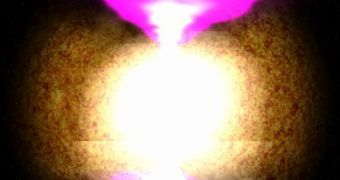In two papers published in the December 1 issue of the top scientific journal Nature, investigators describe two possible explanations for an extremely-weird gamma-ray burst astronomers detected on Christmas Day 2010.
The event was first detected by the NASA Swift spacecraft, and cataloged as GRB 101225A. The main reason why astrophysicists became interested in it is that it lasted for 28 minutes, which is an extremely long time for such an event.
GRB are the brightest, most powerful explosions in the Universe, and they can outshine entire galaxies for very brief periods of time. The amount of energy they put in just a few seconds of shine is significantly higher than what the Sun will have produced throughout its 10-billion-year lifespan.
Another thing that puzzled experts was that subsequent observations of the afterglow GRB 101225A left behind – conducted with the Hubble Space Telescope – were unable to determine the distance at which the gamma-ray burst occurred.
The latter aspect is very important, since it represents a major difference between the two studies. Each research team modeled the event in different ways, and arrived at significantly-different conclusions, either that the event was caused by a distant supernova, or that it was produced by a stellar collision.
“What the Christmas burst seems to be telling us is that the family of gamma-ray bursts is more diverse than we fully appreciate,” explains the lead author of the supernova study, Institute of Astrophysics of Andalusia investigator Christina Thoene.
“It's only by rapidly detecting hundreds of them, as Swift is doing, that we can catch some of the more eccentric siblings,” she adds. The expert says that a neutron star is present in both scenarios, but underlines that this is one of the few common elements the studies share.
Her work suggests that a neutron star in a binary system merged with its massive companion, producing a large black hole, and causing the atmosphere around the star to be ejected. This would have definitely been able to produce a massive GRB, located some 5.5 billion light-years away.
However, according to Brera Observatory investigator Sergio Campana, GRB 101225A was produced by a comet-like object, which fell into a neutron star located some 10,000 light-years away. With this in mind, it's easy to see how finding the distance the event occurred from Earth could solve the mystery.
“The beauty of the Christmas burst is that we must invoke two exotic scenarios to explain it, but such rare oddballs will help us advance the field,” supernova scenario study coauthor Chryssa Kouveliotou explains. The expert is based at the NASA Marshall Space Flight Center, in Huntsville, Alabama.

 14 DAY TRIAL //
14 DAY TRIAL //